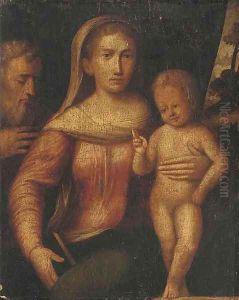Giacomo Francia, Called Raibolini Paintings
Giacomo Francia, also known as Giacomo Raibolini, was an Italian painter, born in 1484 in Bologna. He was the son of Francesco Raibolini, better known as Francesco Francia, who was a prominent painter, goldsmith, and medalist of the early Renaissance period. Under the shadow of his father's considerable reputation, Giacomo developed his artistic skills and eventually took over the family workshop after his father's death in 1517.
He was not as renowned as his father, but Giacomo, together with his brother Giulio, maintained the workshop's output and reputation. The brothers worked in a style that was heavily influenced by their father's approach, which was characterized by a delicate and refined use of color, religious piety, and a harmonious sense of composition. The Francia workshop continued to serve a wide range of clients, including religious institutions, producing altarpieces, devotional paintings, and portraits.
Giacomo's individual contributions have often been difficult to distinguish from those of his brother or their workshop associates due to the collaborative nature of their practice. Nevertheless, some works are attributed to him on the basis of style and documentary evidence. Giacomo's work generally reflects the transition from the High Renaissance to the Mannerist style, though it did not fully embrace the latter's complexity or tension.
Throughout his career, Giacomo faced the challenge of emerging from his father's shadow and developing his own artistic identity. Despite the difficulties in distinguishing his individual style, he was an important figure in the Bologna art scene of his time. Giacomo Francia died in 1557 in Bologna, having spent his life maintaining and contributing to the artistic legacy started by his father.
